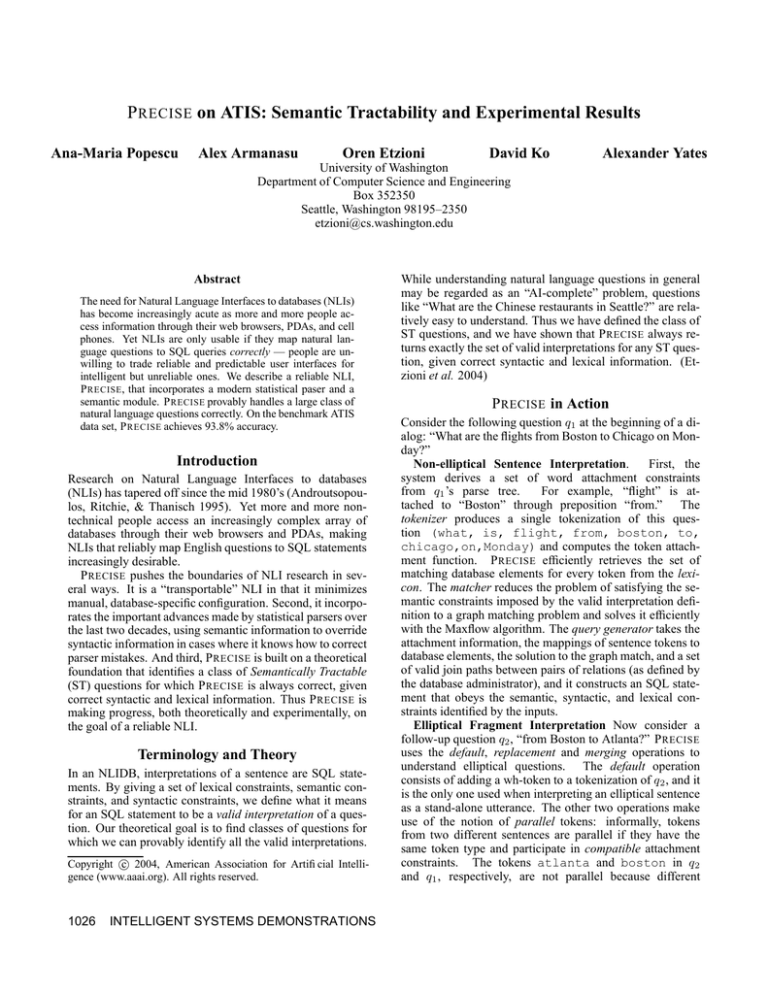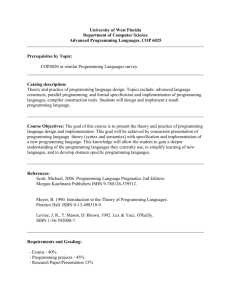
P RECISE on ATIS: Semantic Tractability and Experimental Results
Ana-Maria Popescu
Alex Armanasu
Oren Etzioni
David Ko
Alexander Yates
University of Washington
Department of Computer Science and Engineering
Box 352350
Seattle, Washington 98195–2350
etzioni@cs.washington.edu
Abstract
The need for Natural Language Interfaces to databases (NLIs)
has become increasingly acute as more and more people access information through their web browsers, PDAs, and cell
phones. Yet NLIs are only usable if they map natural language questions to SQL queries correctly — people are unwilling to trade reliable and predictable user interfaces for
intelligent but unreliable ones. We describe a reliable NLI,
P RECISE, that incorporates a modern statistical paser and a
semantic module. P RECISE provably handles a large class of
natural language questions correctly. On the benchmark ATIS
data set, P RECISE achieves 93.8% accuracy.
Introduction
Research on Natural Language Interfaces to databases
(NLIs) has tapered off since the mid 1980’s (Androutsopoulos, Ritchie, & Thanisch 1995). Yet more and more nontechnical people access an increasingly complex array of
databases through their web browsers and PDAs, making
NLIs that reliably map English questions to SQL statements
increasingly desirable.
P RECISE pushes the boundaries of NLI research in several ways. It is a “transportable” NLI in that it minimizes
manual, database-specific configuration. Second, it incorporates the important advances made by statistical parsers over
the last two decades, using semantic information to override
syntactic information in cases where it knows how to correct
parser mistakes. And third, P RECISE is built on a theoretical
foundation that identifies a class of Semantically Tractable
(ST) questions for which P RECISE is always correct, given
correct syntactic and lexical information. Thus P RECISE is
making progress, both theoretically and experimentally, on
the goal of a reliable NLI.
Terminology and Theory
In an NLIDB, interpretations of a sentence are SQL statements. By giving a set of lexical constraints, semantic constraints, and syntactic constraints, we define what it means
for an SQL statement to be a valid interpretation of a question. Our theoretical goal is to find classes of questions for
which we can provably identify all the valid interpretations.
c 2004, American Association for Artificial IntelliCopyright gence (www.aaai.org). All rights reserved.
1026
INTELLIGENT SYSTEMS DEMONSTRATIONS
While understanding natural language questions in general
may be regarded as an “AI-complete” problem, questions
like “What are the Chinese restaurants in Seattle?” are relatively easy to understand. Thus we have defined the class of
ST questions, and we have shown that P RECISE always returns exactly the set of valid interpretations for any ST question, given correct syntactic and lexical information. (Etzioni et al. 2004)
P RECISE in Action
Consider the following question q1 at the beginning of a dialog: “What are the flights from Boston to Chicago on Monday?”
Non-elliptical Sentence Interpretation.
First, the
system derives a set of word attachment constraints
from q1 ’s parse tree.
For example, “flight” is attached to “Boston” through preposition “from.” The
tokenizer produces a single tokenization of this question (what, is, flight, from, boston, to,
chicago,on,Monday) and computes the token attachment function. P RECISE efficiently retrieves the set of
matching database elements for every token from the lexicon. The matcher reduces the problem of satisfying the semantic constraints imposed by the valid interpretation definition to a graph matching problem and solves it efficiently
with the Maxflow algorithm. The query generator takes the
attachment information, the mappings of sentence tokens to
database elements, the solution to the graph match, and a set
of valid join paths between pairs of relations (as defined by
the database administrator), and it constructs an SQL statement that obeys the semantic, syntactic, and lexical constraints identified by the inputs.
Elliptical Fragment Interpretation Now consider a
follow-up question q2 , “from Boston to Atlanta?” P RECISE
uses the default, replacement and merging operations to
understand elliptical questions. The default operation
consists of adding a wh-token to a tokenization of q2 , and it
is the only one used when interpreting an elliptical sentence
as a stand-alone utterance. The other two operations make
use of the notion of parallel tokens: informally, tokens
from two different sentences are parallel if they have the
same token type and participate in compatible attachment
constraints. The tokens atlanta and boston in q2
and q1 , respectively, are not parallel because different
System Setup
P arserORIG, No Over-rides
P arserORIG, Over-rides
P arserAT IS , No Over-rides
P arserAT IS , Over-rides
P arserCORRECT , Over-rides
P RECISE
61.7%
89.5%
92.2%
93.8%
95.1%
P RECISE L
60.1%
85.3%
88.1%
89.1%
91.3%
Table 1: Impact of Parser Enhancements. The P RECISE column records the percentage of questions where the small set of
SQL queries returned by P RECISE contains the correct query;
P RECISE L refers to the questions correctly interpreted if P RE CISE is forced to return exactly one SQL query. P arserORIG
is the original version of the parser, P arserAT IS is the version
re-trained for the ATIS domain, and P arserCORRECT is the
version whose output is corrected manually. Over-rides refer
to the automatic use of semantic over-rides to correct parser
errors.
prepositions mediate their attachment, whereas atlanta
and chicago are parallel because they have similar types
and compatible attachment constraints. The replacement
operation substitutes q2 tokens for parallel q1 tokens. In the
merging operation, if there are tokens in q2 that are not parallel to any in q1 (or vice versa), they are kept as part of the
final tokenization Tq02 . Here are possible tokenizations Tq02 ,
computed using the replacement and merging operations
described above: Tq02 =what, fare, from, boston,
to, atlanta, on, monday, Tq02 =what, fare,
from, boston, to, atlanta.
Experimental Evaluation
Previously, we measured the practical impact of our theoretical framework by assessing the first version of our system
on hundreds of natural language questions compiled by researchers at U.T. Austin (Tang & Mooney 2001) - we obtained 100% precision and approximately 80% recall. We
then evaluated our system on the well-known ATIS dataset.
The scoring set contains 445 context-independent sentences
and 287 context-dependent sentences. There are 9 elliptical context-independent questions and 15 elliptical contextdependent questions. P RECISE was able to interpret ??? out
of the 445 sentences in the A dataset. The rest were intractable either due to parser error (how many???) or due to
intractability of ellipsis. 9 sentences were incorrectly interpreted. P RECISE correctly handles all 15 elliptical contextdependent sentences. The accuracy on transcribed text input
on the A set is 93.8%, which is comparable to the response
error rate of the best ATIS systems (see Table2).
Precise
93.8%
AT&T
96.2%
CMU
96.2%
Table 2: Response error rate comparison: P RECISE vs.
highest-performing ATIS systems.
In another series of experiments, we tested how the behavior of P RECISE changed according to the quality of
the syntactic information it was provided with (see Table
1). We measured P RECISE’s accuracy using the Charniak
parser, the Charniak parser retrained on questions from the
ATIS domain, and manually corrected syntactic information.
Overall, the results improved from 61.7% accuracy to 95.1%
accuracy as the parser improved.
Related Work
There have been a great number of systems built for the
ATIS domain. Semantic parser-based systems (Seneff 1992;
Ward & Issar 1996) used manually-crafted, context-free semantic rules to fill slots in semantic frames. Stoachastic
model-based systems (Levin & Pieraccini 1995) require a
fully annotated corpus to build a reliable model. P RECISE’s,
on the other hand, uses a set of domain-independent semantic constraints and existing parsing technology so that it is
more portable than both kinds of systems while performing
comparably on ATIS.
Mooney’s learning approach to database interfaces requires a great deal of hand tagged sentences, and it emphasizes recall over precision by attempting to interpret sentences with unknown words. As far as handling ellipsis
is concerned, most previous work (such as (Crouch 1995;
Dalrymple, Shieber, & Pereira 1991)) deals with verb phrase
ellipsis and only tangentially mentions noun phrase elliptical
fragments. (Carbonell 1983) requires a semantic grammar,
so the application cannot easily be ported to another domain
and processes only a subset of the elliptical fragments P RE CISE can handle.
References
Androutsopoulos, I.; Ritchie, G. D.; and Thanisch, P. 1995. Natural Language Interfaces to Databases - An Introduction. In Natural Language Engineering, vol 1, part 1, 29–81.
Carbonell, J. 1983. Discourse pragmatics and ellipsis resolution
in task-oriented natural language interfaces. In Proceedings of
the 21st Annual Meeting of the Association for Computational
Linguistics, 164–168.
Crouch, R. 1995. Ellipsis and quantification: A substitutional
approach. In Proceedings of the Seventh Conference of the European Chapter of the Association for Computational Linguistics,
229–236.
Dalrymple, M.; Shieber, S.; and Pereira, F. C. N. 1991. Ellipsis and higher-order unification. Linguistics and Philosophy
14(4):399–452.
Etzioni, O.; Popescu, A.; Armanasu, A.; Yates, A.; and Ko, D.
2004. Semantically tractable questions and follow-up questions
in the atis data. In Submitted to Coling-2004.
Levin, E., and Pieraccini, R. 1995. Chronus, the next generation. In Proceedings of the DARPA Speech and Natural Language
Workshop, 269–271.
Seneff, S. 1992. Robust parsing for spoken language systems. In
Proceedings of the IEEE International Conference on Acoustics,
Speech and Signal Processing.
Tang, L., and Mooney, R. 2001. Using multiple clause constructors in inductive logic programming for semantic parsing. In Proceedings of the 12th European Conference on Machine Learning
(ECML-2001), Freiburg, Germany, 466–477.
Ward, W., and Issar, S. 1996. Recent improvements in the cmu
spoken language understanding system. In Proceedings of the
ARPA Human Language Technology Workshop, 213–216.
INTELLIGENT SYSTEMS DEMONSTRATIONS 1027






